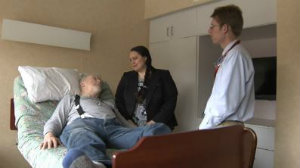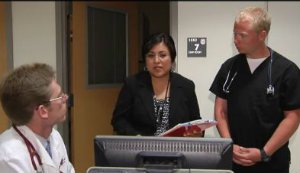 Dr. Timothy W. Farrell, right, from the video series depicting a patient undergoing transitions of care across different locations of care.
Dr. Timothy W. Farrell, right, from the video series depicting a patient undergoing transitions of care across different locations of care.It happens all too often: Older adults “fall through the cracks” of the health care system. They fall victim to bad transitions of care due to a host of issues, including poor communication, a lack of geriatrics expertise on the part of the health care provider, and a dysfunctional or non-existent team.
As a result, older adults are rehospitalized, frequently move across sites of care, and receive suboptimal and, too often, harmful services.
The John A. Hartford Foundation has been in the Care Transitions business for some time. Over more than a decade, we have invested more than $26.4 million in innovators such as Mary Naylor, Mark Williams, June Simmons and others to support the development, testing, and dissemination of evidence-based approaches that improve transitions of care. Eric Coleman’s Care Transitions Intervention, another model we have supported through the years, is aimed at “helping older adults move from the back seat to the passenger seat to the driver’s seat.”
Moreover, Hartford staff have blogged about the need for quality team care driving person-centered care transitions ( Read Continuing to Put the IT in Care TransITions, Putting the IT in Care TransITions, and Social Workers Are Best for Care Transitions.
 Dr. Farrell, left, consults on a patient's care transition on the video.
Dr. Farrell, left, consults on a patient's care transition on the video.In this installment of our Tools You Can Use series, Timothy W. Farrell, MD, assistant professor of medicine and adjunct assistant professor of family medicine within the Division of Geriatrics at the University of Utah School of Medicine and a Physician Investigator with the VA SLC Geriatric Research, Education, and Clinical Center, shares the Geriatric Transitions Objective Structured Video Examination (GT-OSVE). This series of videos—a product of a HRSA Geriatric Academic Career Award (GACA) grant mentored by Cherie Brunker, MD—is a series of three video cases depicting a patient undergoing transitions of care across different locations of care. The GT-OSVE may be used as an evaluative tool to assess interdisciplinary health professions trainees' ability to formulate transitions plans and to assess team functioning.
The ultimate goal of this well-designed and produced resource is to arm health care providers with the skills and knowledge to deliver quality, team-based, geriatric-competent care.
The videos and materials are free to use. You simply have to complete a quick registration form.
Dr. Farrell reports the video series was created because, although there is increasing recognition of the importance of transitional care, including clinical programs and payment system reforms designed to reduce hospital readmissions rates, educational initiatives to equip the health care workforce to perform effective transitional care have lagged behind these clinical and payment system initiatives.
He expects the impact of the GT-OSVE cases to include increased knowledge, understanding and self-efficacy among interdisciplinary health professions trainees in executing successful transitions of care.
Dr. Farrell also states that primary care physician trainees and faculty can benefit from the cases and supporting materials. It is hoped that by learning best practices in transitional care, they will be able to organize a post-hospital encounter accordingly and therefore be less overwhelmed by the demands of a complicated transition within the constraints of a short office visit.
The GT-OSVE cases model critical aspects of transitional care among older adults, including the role of care management, pre-visit planning, and the provision of after-visit instructions. They also allow health professions trainees to actively engage in formulating transition plans.
“In this regard, we expect the GT-OSVE to facilitate culture change among those institutions that implement this product, with faculty and trainees hopefully being better prepared to provide optimal transitional care for older adults,” note Drs. Farrell and Brunker.
Optimal transitional care for older adults is a goal the Hartford Foundation has long supported. I encourage you to use these videos to help bring that goal closer to reality.
This is the eighth in an occasional series. See other Health AGEnda posts on Tools You Can Use:
Tools You Can Use: A New APProach to Treating Older Patients
Tools You Can Use: Detecting Cognitive Impairment During the Medicare Annual Wellness Visit
Tools You Can Use: Preparing a Personal Advance Care Plan
Tools You Can Use: Guidelines for Assessing Patients Facing Surgery
Tools You Can Use: Principles for Treating Patients with Multiple Chronic Conditions
